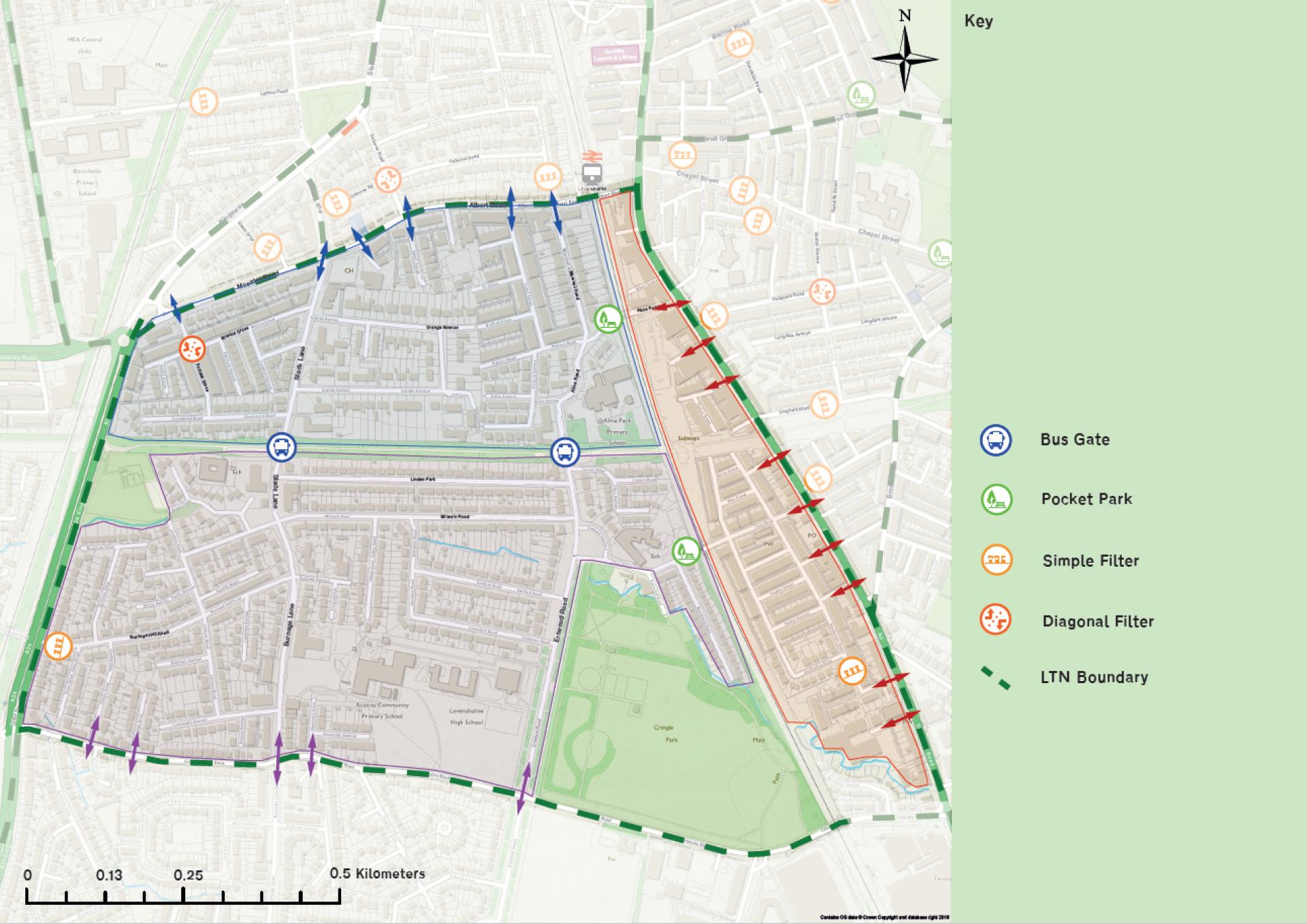Once the indicative location for an intervention has been identified, there are more things to consider to ensure it is as successful as possible.

Figure 5e: LTN proposals and vehicle access routes.
When placing and designing filters, there are several detailed design considerations which must be taken on board.
Figure 5e shows the proposals for the low-traffic neighbourhood developed in Section 5.3, clearly highlighting the access routes for motorised vehicles from each boundary road.
Filter type (Filters that don’t block cars but activate streets)
Wherever possible, single filters have been upgraded to pocket parks (i.e filters with two sets of bollards), particularly next to schools, community centres or other areas of high footfall.
This should be a standard approach across LTNs, ensuring modal filters activate streets rather than simply restrict traffic.
Balance of Access
The placement of filters determines which boundary road each property is accessed from by private motor vehicle. In the example above, vehicle access to most properties is from the northern and southern boundary roads, with a smaller number accessed from the east and none from the west.
To mitigate potential negative impacts on a particular boundary road, the number of properties accessed from there can be reduced.
In this case, the eastern boundary road (the A6) is a key shopping destination and cycle route.
Therefore placing filters closer to it minimises the number of vehicles using this boundary road for access, and in turn the danger from turning movements.
Existing restrictions (banned turns, width restrictions, one ways)
When placing modal filters, it is essential to consider any existing restrictions on vehicle movements, which could include height restrictions under bridges, width restrictions or banned turns.
In the example above, the pocket parks have been placed under the railway bridges, which have 3.9m height restrictions.
If the filters had been placed further west, some properties would have been inaccessible by vehicles taller than 3.9m.
The western boundary road is a dual carriageway with no property frontages, meaning it is most suited for heavy traffic volumes.
However, the existing banned turns along it mean that, if properties were to be solely accessed from this road, local residents would likely have be forced into very long detours, or dangerous u-turns at junctions.
Banned turns at the corners of an LTN are considerably more challenging, particularly when signalised.
The banned movements should usually be permitted before the LTN restrictions are introduced, or they may otherwise result in extremely long detours for car journeys, or in dangerous u-turns and three-point turns on residential streets just outside the LTN.
In the case of width restrictions, either a new modal filter is placed at the location of the existing restriction, or it may have to be removed, to ensure larger vehicles can access all properties.
In many cases, existing one-way streets can be converted back to two-way, to allow the placement of a modal filter and maintain access to properties.
When determining the balance of access by drivers, it is important to understand the preferences of residents alongside these traffic and safety considerations.
Camera enforcement and turning headsPhysically enforced filters deliver higher benefits, particularly when activated, and are preferable.
While designing, consider building line to building line, ensuring gaps do not allow motor vehicles through.
When choosing where to place a filter along a street, turning heads for larger vehicles, reversing distances and safety at junctions are important considerations.
To minimise inconvenience to emergency services, consider having a couple of strategically placed camera-enforced modal filters in the LTN (such as the bus gates in the example above), which can create priority corridors for blue light services.
Rather than just signage, wherever possible, planters and street furniture should be introduced to change the nature of the street and improve compliance with the camera enforced filter.
Mapping providers and signage
Finally, once an LTN is implemented, liaising with mapping providers to update filtered routes is essential.
Otherwise, drivers will continue to incorrectly be directed through the neighbourhood, increasing confusion, reducing safety and compliance.
Advance signage on boundary roads can help reduce vehicles turning into the LTN.

